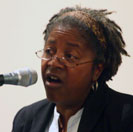Community fights gentrification in Harlem
By
Imani Henry
Published Dec 4, 2005 11:02 PM
Part I reported the attempts to gentrify New
Orleans following Hurricane Katrina’s devastation.
Nellie
Bailey of the Harlem Tenants Council in New York, which is fighting the
gentrification of Harlem, said: “In Harlem and in cities around the
country the gentrification has been a gradual process, over several years or
decades. In New Orleans since the hurricanes it has been wholesale displacement,
in one fell swoop.”
The New York City social service agency,
Coalition for the Homeless, says there are 36,166 people who sleep in the
city’s shelters and welfare hotels each night, and 14,884 are children.
“Those statistics are only the tip of the iceberg.” Bailey
told Workers World, “We can’t account for the people who live on the
street, or who are staying with friends and families, doubling and tripling up
in small apartments. Families are being pushed out by terrible living
conditions, or evicted by landlords because they can’t afford the
rents.”
Bailey stated that the 2004 Vera Institute for
Justice’s study on family homelessness in New York showed that, among
other factors, neighborhoods experiencing gentrification like Central Harlem had
higher numbers of families becoming homeless. Central Harlem ranked in the top
10 neighborhoods in the city with a high displacement rate.
In the last
two years, a new grassroots movement, The Coalition to Preserve Community, has
led the opposition to gentrification of West Harlem. One of the city’s
largest landlords, Columbia Uni versity, is carrying out this gentrification
with the support of New York Mayor Michael Bloomberg. Columbia’s Manhat
tan ville Expansion Plan is a 17-acre land grab aimed at doubling the size of
the university’s campus by using the law of eminent domain, which allows
the government to seize land.
Many fear the plan will displace homes and
small businesses from 125th Street to 133rd in the West Harlem area. The
crowning goal of Columbia’s plan is to build a bio-chemical research
center, which would have five stories below ground level, potentially wreaking
havoc on the environment.
The Coalition to Preserve Community has united
community groups, such as Harlem Tenants Council, together with workers’
and students’ groups from Columbia itself to fight the plan. For two years
activists have gone door to door with literature and held rallies and press
conferences to expose the back-room deal between the Bloomberg administration
and Columbia.
On Nov. 16, over 300 people attended the first public
hearing to discuss Columbia’s plan. The participants included community
members, environmentalists, students, religious leaders and business owners, who
came out to give Columbia a resounding “No!”
According to the
student newspaper the Columbia Spectator, during the six-and-half hour hearing,
all 70 people who took the floor opposed the expansion plan. Some were so
outraged that they continued to speak even after their microphones were cut
off.
Both New Orleans and Harlem are seen historically as Black cultural
centers in the United States. Both are world-renowned for their music and food.
Both Harlem and New Orleans are birthplaces of culture and community for
lesbian, gay, bi and trans people, especially of color.
The people of both
Harlem and New Orleans, and those in many urban centers across the country, are
engaged in the struggle for the right of self-determination and to stop the
racist displacement of entire communities through gentrification. At the heart
of this struggle is the lack of affordable housing in the city. Under
capitalism, affordable housing, like jobs, access to quality education and
healthcare, is not treated as a human right, but as a privilege for those with
money.
According to Bailey, “Across the country, you can see U.S.
capitalists’ aim with gentrification is to follow the European model. The
inner cities were once for the poor and working class, for communities of color.
But now they will be only for the wealthy. The working class will be priced out
and forced to commute in from suburban ghettos, like in France.”
As
the fiery uprisings in those suburbs of Paris have shown, for the ruling class,
the displacement and disenfranchisement of working and poor people will always
come with a price.
Articles copyright 1995-2012 Workers World.
Verbatim copying and distribution of this entire article is permitted in any medium without royalty provided this notice is preserved.
Workers World, 55 W. 17 St., NY, NY 10011
Email:
[email protected]
Subscribe
[email protected]
Support independent news
DONATE


